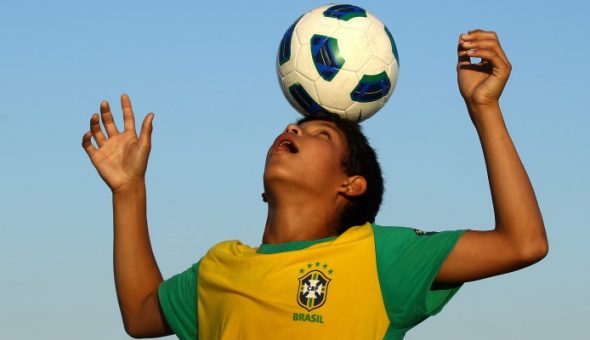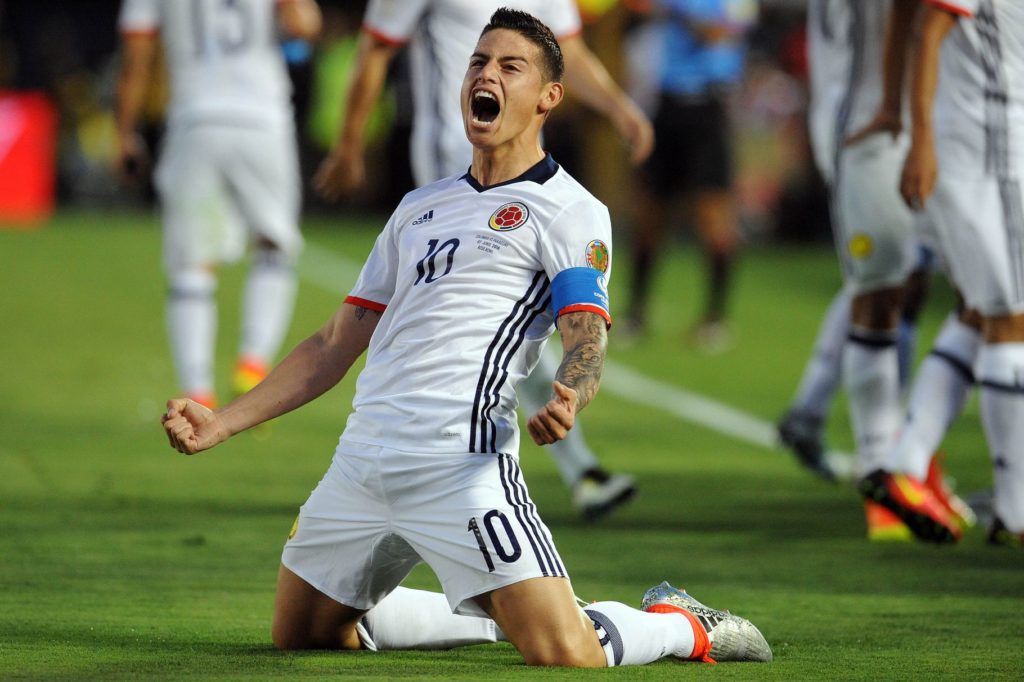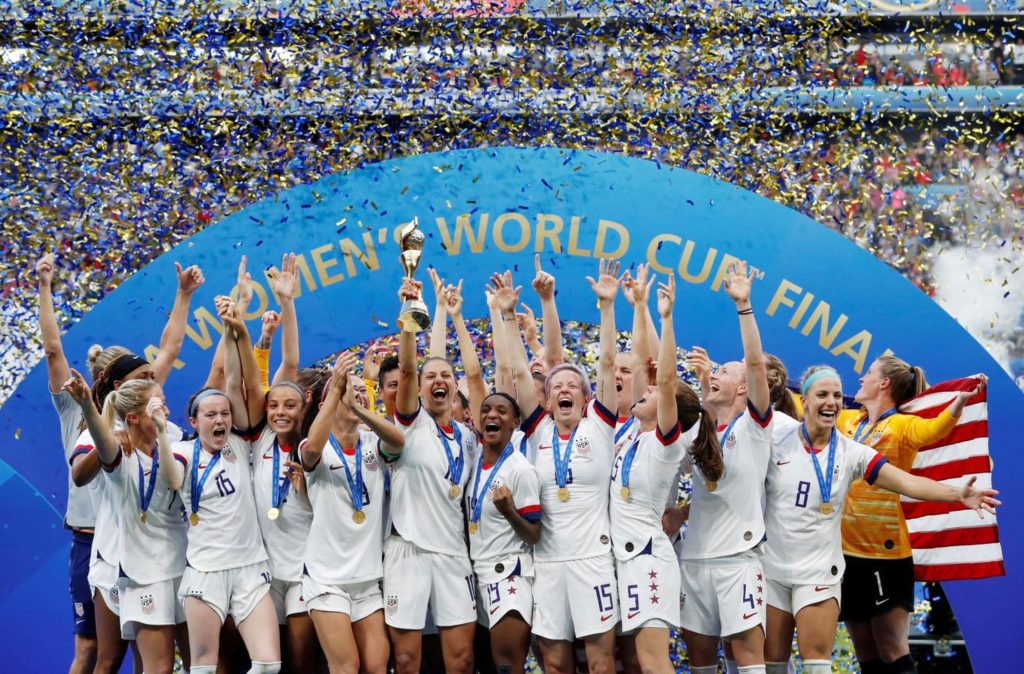Last Friday was my son’s tenth birthday. A summer baby, he annually confronts the absence of routine, structure, and often friends in town during this, the best of seasons. If that last bit didn’t give it away, I can relate because I, too, have a summer birthday, and so I usually compensate for us both by planning celebrations that capitalize on the best bits of the hot months, things like pools, water parks, and highly air conditioned movie theaters. When this year my son suggested we take him and a few buddies to an evening baseball game in high-tech, well-ventilated Marlins Park, I was thrilled.
My husband and I sat down to count up the seats we would purchase when the text arrived from one of the first guests — grandpa. Baseball, how fun, he said, but that same night Colombia plays Chile in the Latin American summer tournament, the Copa America. My husband and I looked at each other. This heritage soccer tournament, played every two years, features 18 teams from continental and Caribbean Latin countries, including Jamaica and Central America (but not the U.S. or Canada), is one of the most compelling stages for South American soccer. We knew we preferred to watch the quarter final match, celebrating that our birth country had qualified together with the birth of our son, but didn’t know how our decade-old American would feel.
The kid didn’t even let us finish the sentence before he announced his decision: fútbol for sure. He remembered how in the last two World Cups (2018 and 2014), Colombia’s games have magically dovetailed with the anniversary of his summer birth. Both times, Colombia has won, convincing this kid (who would say he’s not superstitious but he’s a little “stitious”) that combining his special day to the game gives the players that extra vote of confidence that will push them toward victory.
In the past, he’d enlisted his younger brother’s help in producing handmade signs and crafting cheers. He also tends to quickly invoke the family rule that stadium speak can include terms and formulations more vulgar than those of our regular life — swearing without consequences is a huge draw for a tween. But to trade in all the cotton candy, mystery dogs and popcorn so salty my kidneys contort at the thought for a more wholesome homemade party? A rowdy and reprimand-less mess for the constraints of having to party in his own home? Would he be satisfied by the birthday soccer-viewing experience?
For his father and I, and certainly for our parent’s generation, el fútbol holds an importance ascribed to few other phenomena, which moves far more millions of dollars around and influences the aspirations of so many people worldwide. We all grew up in a country in which these effects of an organized sport on the life and culture of entire nations was palpable in every walk of life and across the rigidly divided social classes. At the stadium, everyone feels equal, as individuals become a unit: la barra or the cheering squad. The players on the field run and score, all eyes and hearts stay with their stats and their stories, like gladiators of a democratic moment that only exists beyond the reach of government and dissolves into the ether when the stands empty out into the city streets.

Much like basketball fits the topography of an American city, with its fenced in concrete courts and conservative team sizes, easily scaled as far down as a pick-up game of just one on one, so, too, is soccer the game that best suits packs of numerous youth in rural and underserved regions. El fútbol is the most popular sport in Europe, where the soccer clubs have the cash to train amazing athletes and to recruit more amazing athletes from Latin America, Asia, and Africa. It is also the most popular sport in Latin America, Asia, and Africa, where one soccer ball and an open, bare space can entertain up to 22 young people at a time, making use of the rural or under-built spaces they inhabit and requiring little to no additional equipment, in many cases not even a pair of shoes.
Playing soccer professionally is aspirational, one of the only ways in which some of these nations are positively represented, the only route for certain young men to escape poverty. Players since the great Pelé of Brazil, inclusive of so many others since him, many of them stars of national line-ups who play for European clubs during the year, were made on their native streets, learning to dribble and shoot barefoot. Following the black-and-white ball all the way out of the tugurio or favela has been a decidedly positive recourse for many individuals from Latin America, who have shared their world renown, mentorship, and fortune with their country. Nations that tend to appear within headlines over negative news stories about unstable governments or crime and inequality, can shine in their role on this particular playing field.
For example, Colombia’s very young rookie James Rodriguez achieved immediate fame when he performed in the 2014 World Cup, carving himself a route that took him all the way to a 70 million dollar salary from Bayern Munich in 2018. When the newspapers mention Colombia together with excellence in soccer, I breathe a sigh of relief. As children of the 1980s, my husband and I are still exhausted from the negative press of the cocaine years, far more interested in highlighting the many fabulous exports from our country.

All of this good press and transcending our human condition has been a positive outlet for many developing nations, no doubt, but to think that this particular playing field is completely even would be naive. Fútbol in its major-league, life-altering, nation-driving applications has drummed up a lot of positivity, yes, though its ability to influence economies and politics has also produced some toxic side-effects. Beginning with its regulating body, FIFA is an organization based out of politically neutral, financially discreet Switzerland, headed up by…you guessed it: a panel of older, white males. A bunch of white guys move around a ton of funds to engage a motley crew, including lots of brown guys, to play for the amusement of the world television viewers. This lucrative enterprise is not always pure.
While some of FIFA’s moves are better than others, they have certainly taken some self-interested and myopic decisions, such as placing the burden of building infrastructure on an already-struggling nation (Brazil 2014) or the super-questionable plan to hold an off-season tournament in Qatar in winter of 2022. The seasonal rescheduling was a concession to critics who cited the extremely hot temperatures in the Middle East during the summer as a health concern for players, early in Qatar’s bidding process. Moving the games to the winter may help to mitigate the unnaturally extreme heat for the soccer players, though it does not address the concern about the illnesses and deaths caused in workers who have been building arenas and other infrastructure in preparation for the event. The loss of revenue from lack of alcohol sales and endorsements, as these are illegal in Qatar, is another factor, one that FIFA will experience and evaluate for the first time in its history in 2022.
The other big issue in European soccer, aside from diverse national teams and international decisions being regulated in this rather colonialist fashion, is that the discrepancy between the spending power of the European clubs and virtually everyone else, is staggering. Soccer clubs pay their star players very generously, placing the bulk of their resources on a few (Messi, Sanchez) and then spreading around the remaining crumbs. Moreover, some clubs (Real Madrid, Barcelona) have far more spending power than others (Leicester, last year’s winner of the European cup), and all of these iniquities mirror the ones at large in the Latin societies from whence players often hail. The result of South Americans playing year-round in lucrative European line-ups and returning to play alongside national teammates who make a tiny fraction of their salary is an over-inflated version of the “grotesque disproportion” that Oxfam, an NGO that monitors poverty and social inequality, perceives in both soccer and society in Latin America.
Whatever positive press a winning soccer team’s performance on the world stage can bring, this perpetuation of social and economic inequality lies in contradiction to the machinery of democracy. In the opinion of Mexican economists, the United States has solved this underlying problem of disparate earning potentials by recruiting professional players through a more egalitarian “draft” method and placing earning caps on players, for example on David Beckham, brought in to elevate, not bankrupt, the Los Angeles Astros. Despite the American’s lower enthusiasm towards soccer than that of most other nations, the lessons of politics applied here hold up: the more equal treatment and compensation of players, the more that pitch gets leveled, every player given equal opportunity to dazzle the fans.
There are many arguments to be made in favor of soccer as a mover of the masses, maker of positive entropy. Many of these arguments, though, contain an essence of their shadow-self, too. Yes, cheering on a national team of well-paid players builds patriotism, a sense of camaraderie and regional pride. Community-building and creating identity is a wonderful side effect of participating in the sport as a viewer.
But there is a seedy side to the devotion, the violence of the fans and hooligans, woven into the very fiber of the culture in stadiums around the world. From the adversarial nature of confrontations between fans of separate teams, mimicking the encounters between gangs, to the general chaos of emotions distorted by adrenaline and alcohol, stadiums and bars are too often the setting for violence.
Even in the relative peace of fandom that keeps their hands to themselves, critics will point out that the involvement is a mirage and the excitement that fans bring is not easily transferable to other realms of civic action, like voting and social responsibility. Instead of viewing the entertainment soccer provides as a salve, it is charged with manipulating and lulling the masses, while holding out a fictional carrot of aspiration, unachievable by most and grotesquely outside the realm of necessity or propriety.
And while the sporting events are certainly highly lucrative, such as the large subsidy Brazil received for the construction of World Cup infrastructure, the clear winners in these cases are the big builders and contractors, not the developing nation or its citizens. Some of the players are disadvantaged kids who strike it big, yes, but the percentage of people who will get ahead through a career in soccer is minute compared to those who will be receive a sort of mass hypnosis as they experience an adrenaline rush and catharsis through their national sports team, a virtual experience with little lasting psychological or sociological value, according to German journalist and philologist, Santiago Flores Alvarez-Ossorio.
Perhaps most obvious to us is the historical exclusion of one half of the population from the soccer pitch. None of the leagues on any of the continents featured female players until FIFA made space for the national women’s leagues that now play in the Women’s Cup, also held every four years. Despite the widespread fandom amongst women, 46% of us worldwide identifying as fiercely passionate about our local or national team, we didn’t have a stage for our own fancy footwork until 1991 saw China host the first female tournament. Since then, the Women’s Cup has grown exponentially, in viewership, participation, and revenue production.

Just as in the may other realms in which women are capable of holding their own just as well as men, the world of fútbol is built around a gender inequality that governs a large pay gap that favors men at the individual, team, and national levels. Even less inspiring is the trend that has only widened the gap in recent years. Even though the women’s teams bring in more fans each day, everything from player salaries to the prize money for the winners of the women’s and men’s Cup has only grown more disparate. Individual players of international renown earn a fraction of what their male counterparts are awarded. Mia Hamm, who started clamoring for pay equality back in the 1990s when she was helping the USA team bring home trophies, now stands by Megan Rapinoe, Carli Lloyd, and Alex Morgan, who are so underpaid they have been able to bring a suit against the US Soccer Federation.
In spite of the insufficient support, women’s USA team continues to perform impressively on the international stage and many continue to question those in charge of organizing and compensating the players. Commenting on the difference between the $30 million FIFA will give the winners of this summer’s women’s tournament and the $440 million they have slated for the winners of the men’s tournament in 2022, the former head of the women’s tournament for FIFA, Tatjanna Haenni, manages to muster adjectives like “ridiculous” and “disappointing,” citing a preoccupation with the bad messaging that this downward trend in the prizes sets. Given this absurd disparity, some might question why the women’s teams would keep pushing themselves so hard to excel, perform so well, and involve themselves in other aspects of democratic life.
Of course, it isn’t just FIFA who pays women less; the pay gap is wide and real between women and men across sports. Women in the league continue to make their case for pay equality and to provide representation, with many of them playing the kind of world-class soccer that makes men famous. Women have demonstrated their prowess on the pitch, setting records as impressive as the men’s. The only real difference seems to be how hard they have to work at being supported, respected, taken seriously, and paid their worth.
By the time our son was done saying he’d rather watch the Colombia game, I had already planned to mix a batch of his favorite cereal and marshmallow bars (instead of a more labor-intensive cake), with guayaba y queso in honor of la patria. That night, despite his track record as a good luck charm, my Colombo-American kid could not save our country from their curse of always losing to Chile on the pitch. “Like the curse of the Bambino on the Sox,” remarked my baseball fan. “It might ok that Colombia lost,” he said later that week when I shared my annoyance that held concurrently with the Copa América finals, relieved that he can now root for his other team, the women’s team USA, in their match on Saturday.
For Image credit or remove please email for immediate removal - info@belatina.com






































